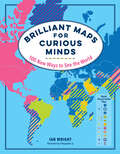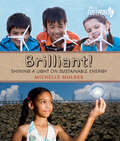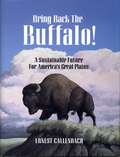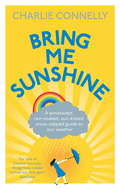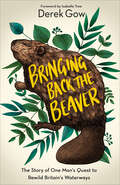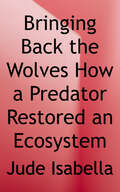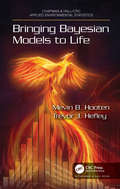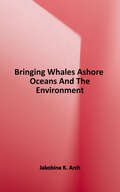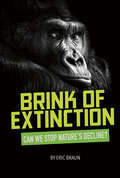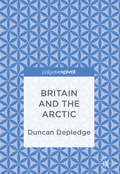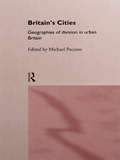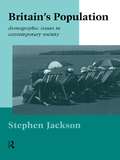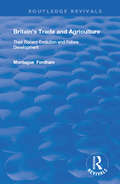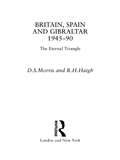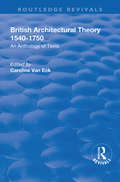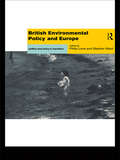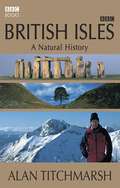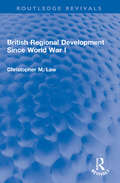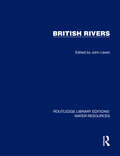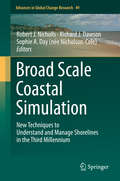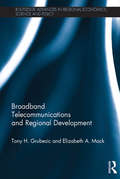- Table View
- List View
Brilliant Maps for Curious Minds: 100 New Ways To See The World (Maps for Curious Minds #0)
by Ian WrightA singular atlas of 100 infographic maps from thought-provoking to flat-out fun. And don’t miss the next book in the series, North American Maps for Curious Minds! Publisher’s note: Brilliant Maps for Curious Minds was published in the UK under the title Brilliant Maps. Which countries don’t have rivers? Which ones have North Korean embassies? Who drives on the “wrong” side of the road? How many national economies are bigger than California’s? And where can you still find lions in the wild? You’ll learn answers to these questions and many more in Brilliant Maps for Curious Minds. This one-of-a-kind atlas is packed with eye-opening analysis (Which nations have had female leaders?), whimsical insight (Where can’t you find a McDonald’s?), and surprising connections that illuminate the contours of culture, history, and politics. Each of these 100 maps will change the way you see the world—and your place in it.
Brilliant!: Shining a light on sustainable energy (Orca Footprints #3)
by Michelle MulderDid you know that cars can run on french-fry grease or that human poop can be used to provide power to classrooms? Brilliant! is about what happens when you harness the power of imagination and innovation: the world changes for the better! Kids in Mexico help light up their houses by playing soccer, and in the Philippines, pop-bottle skylights are improving the quality of life for thousands of families. Full of examples of unusual (and often peculiar) power sources, Brilliant! encourages kids to look around for new and sustainable ways to light up the world.
Bring Back the Buffalo!: A Sustainable Future For America's Great Plains
by Ernest Callenbach Hans CallenbachIn Bring Back the Buffalo!, Ernest Callenbach argues that the return of the bison is the key to a sustainable future for the Great Plains. Vast stretches of the region have seen a steady decline in population and are ill-suited for traditional agriculture or cattle ranching. Yet those same areas provide ideal habitat for bison. Callenbach explores the past history, present situation, and future potential of bison in North America as he examines what can and should be done to re-establish bison as a significant presence in the American landscape. He looks forward with high hopes to a time when vast herds of buffalo provide permanent sustenance to the rural inhabitants of the Great Plains and again play a central role in the balance of nature.
Bring Me Sunshine: A Windswept, Rain-Soaked, Sun-Kissed, Snow-Capped Guide To Our Weather
by Charlie ConnellyWe talk about the weather a lot. It exasperates, confounds and on occasion delights us. Our national conversation is dominated by the weather, but how much do we really know about it? In Bring Me Sunshine, Charlie Connelly sets off on the trail of our island obsession. He breezes through the lives of meteorological eccentrics, geniuses, rainmakers and cloud-busters and brings vividly to life great weather events from history. He sheds light on Britain's weirdest wind, why we have the wettest place in England to thank for the trusty pencil, the debt that umbrella owners owe to Robinson Crusoe and why people once thought firing cannons at clouds was a great idea. Having adventured round the shipping forecast areas for his bestselling Attention All Shipping, Connelly is the perfect guide through a mélange of gales, blizzards, mists, heatwaves and the occasional shower of fish. By turns informative, entertaining and hilarious, Bring Me Sunshine answers all your weather questions as well as helping you to distinguish your graupel from your petrichor.
Bring Science Alive! Planet Earth
by Teachers' Curriculum InstituteBring Science Alive! Planet Earth
Bring Science Alive! Planet Earth (History Alive! Series)
by Teachers’ Curriculum Institute Andrew DakhilNIMAC-sourced textbook
Bringing Back the Beaver: The Story of One Man's Quest to Rewild Britain's Waterways
by Derek GowA bold new voice in nature writing, from the front lines of Britain's rewilding movement Bringing Back the Beaver is farmer-turned-ecologist Derek Gow’s inspirational and often riotously funny firsthand account of how the movement to rewild the British landscape with beavers has become the single most dramatic and subversive nature conservation act of the modern era. Since the early 1990s – in the face of outright opposition from government, landowning elites and even some conservation professionals – Gow has imported, quarantined and assisted the reestablishment of beavers in waterways across England and Scotland. In addition to detailing the ups and downs of rewilding beavers, Bringing Back the Beaver makes a passionate case as to why the return of one of nature’s great problem solvers will be critical as part of a sustainable fix for flooding and future drought, whilst ensuring the creation of essential lifescapes that enable the broadest possible spectrum of Britain’s wildlife to thrive.
Bringing Back the Beaver: The Story of One Mans Quest to Rewild Britains Waterways
by Derek Gow&“Derek Gow might be the most colorful character in all of Beaverdom.&”—Ben Goldfarb, author of Eager"Gow&’s triumph has been the reintroduction of the Eurasian beaver."—The New YorkerBringing Back the Beaver is farmer-turned-ecologist Derek Gow&’s inspirational and often riotously funny firsthand account of how the movement to rewild the British landscape with beavers has become the single most dramatic and subversive nature conservation act of the modern era. Since the early 1990s—in the face of outright opposition from government, landowning elites, and even some conservation professionals—Gow has imported, quarantined, and assisted the reestablishment of beavers in waterways across England and Scotland.In addition to detailing the ups and downs of rewilding beavers, Bringing Back the Beaver makes a passionate case as to why the return of one of nature&’s great problem solvers will be critical as part of a sustainable fix for flooding and future drought, whilst ensuring the creation of essential lifescapes that enable the broadest possible spectrum of Britain&’s wildlife to thrive.&“Bringing Back the Beaver is a hilarious, eccentric and magnificent account of a struggle . . . to reintroduce a species crucial to the health of our ecosystems.&”—George Monbiot&“A treasure.&”—Booklist
Bringing Back the Wolves: How a Predator Restored an Ecosystem (Ecosystem Guardians Series)
by Jude IsabellaBy 1926, there were no grey wolves left in Yellowstone National Park, due to a programme by the US government to eliminate threats to livestock. As a result virtually every other part of the park's ecosystem was affected and the landscape was in distress. <p><p>In 1995, in an attempt to reverse this decline, the government reintroduced grey wolves to the park, and a remarkable restoration took place. This fascinating tale is accompanied by beautiful nature art by Kim Smith as well as educational back-matter such as a glossary, food web infographics, and an index.
Bringing Bayesian Models to Life (Chapman & Hall/CRC Applied Environmental Statistics)
by Mevin B. Hooten Trevor J. HefleyBringing Bayesian Models to Life empowers the reader to extend, enhance, and implement statistical models for ecological and environmental data analysis. We open the black box and show the reader how to connect modern statistical models to computer algorithms. These algorithms allow the user to fit models that answer their scientific questions without needing to rely on automated Bayesian software. We show how to handcraft statistical models that are useful in ecological and environmental science including: linear and generalized linear models, spatial and time series models, occupancy and capture-recapture models, animal movement models, spatio-temporal models, and integrated population-models. Features: R code implementing algorithms to fit Bayesian models using real and simulated data examples. A comprehensive review of statistical models commonly used in ecological and environmental science. Overview of Bayesian computational methods such as importance sampling, MCMC, and HMC. Derivations of the necessary components to construct statistical algorithms from scratch. Bringing Bayesian Models to Life contains a comprehensive treatment of models and associated algorithms for fitting the models to data. We provide detailed and annotated R code in each chapter and apply it to fit each model we present to either real or simulated data for instructional purposes. Our code shows how to create every result and figure in the book so that readers can use and modify it for their own analyses. We provide all code and data in an organized set of directories available at the authors' websites.
Bringing Whales Ashore: Oceans and the Environment of Early Modern Japan
by Jakobina K. ArchJapan today defends its controversial whaling expeditions by invoking tradition--but what was the historical reality? In examining the techniques and impacts of whaling during the Tokugawa period (1603-1868), Jakobina Arch shows that the organized, shore-based whaling that first developed during these years bore little resemblance to modern Japanese whaling. Drawing on a wide range of sources, from whaling ledgers to recipe books and gravestones for fetal whales, she traces how the images of whales and by-products of commercial whaling were woven into the lives of people throughout Japan. Economically, Pacific Ocean resources were central in supporting the expanding Tokugawa state. In this vivid and nuanced study of how the Japanese people brought whales ashore during the Tokugawa period, Arch makes important contributions to both environmental and Japanese history by connecting Japanese whaling to marine environmental history in the Pacific, including the devastating impact of American whaling in the nineteenth century.
Brink of Extinction: Can We Stop Nature's Decline? (Informed!)
by Eric BraunAn intergovernmental science agency recently concluded that one million species, plants, and animals are at risk of extinction because of nature's dangerous decline. What is the cause of this decline? And what are humans doing to protect themselves and other species? Readers will discover the facts behind this issue, the interconnectedness of species on Earth, and the immediate action needed to address the rapid loss of biodiversity.
Britain and the Arctic
by Duncan DepledgeBritish interest in the Arctic has returned to heights not seen since the end of the Cold War; concerns about climate change, resources, trade, and national security are all impacted by profound environmental and geopolitical changes happening in the Arctic. Duncan Depledge investigates the increasing geopolitical significance of the Arctic and explores why it took until now for Britain - once an 'Arctic state' itself - to notice how close it is to these changes, what its contemporary interests in the region are, and whether the British government's response in the arenas of science, defence, and commerce is enough. This book will be of interest to both academics and practitioners seeking to understand contemporary British interest and activity in the Arctic.
Britain's Cities: Geographies of Division in Urban Britain
by Michael PacioneUneven distribution of life is a dominant feature of the city. Major social, economic and spatial divisions are apparent in terms of income and wealth, health, crime, housing, and employment. This text offers an introduction to current processes of urban restructuring, geographies of division and contemporary conditions within the city. The geography of Britain's cities is the outcome of interaction between a host of public and private economic, social and political forces operating at a variety of spatial scales from the global to the local. A deeper understanding of the nature of urban division and of the problems of and prospects for local people and places in urban Britain must be grounded in an appreciation of the structural forces, processes and contextual factors which condition local urban geographies. This book combines structural and local level perspectives to illuminate the complex geography of socio-spatial division within urban Britain. It combines conceptual and empirical analyses from researchers in the field.
Britain's Population: Demographic Issues in Contemporary Society
by Steven JacksonBritain's Population addresses issues relating to the demographic characteristics of British society. Many of the contemporary features of the population relate to changes in the past - particularly the ups and downs in attitudes to marriage and family formation. The history of these trends is considered, including the 'baby boom' of the 1960s when three million children were added to the population within the space of ten years. Jackson argues that the impact of this bulge generation can still be identified and will become of increasing importance when thegeneration reaches retirement age. Current trends in fertility are influenced by the changing structure of the labour market and by the delay in marriage and child bearing to later life. The 1990s has been the era of the 'double income no kids yet' partners and the thirty-something mother. In this book Stephen Jackson highlights how the plight of single mothers, the problem of funding pensioners, and the future of the welfare state, all depend on demographic trends in society.
Britain's Trade and Agriculture: Their Recent Evolution and Future Development (Routledge Revivals)
by Montague FordhamPublished in 1932: The author in his Britain's Trade and Agriculture, though almost ruthlessly exposes the fallacies that lie behind the modern accepted views on industry and agriculture, though he obviously writes without desire to attract attention, but simply to clarify facts and to suggest practical solutions.
Britain, Spain and Gibraltar 1945-1990: The Eternal Triangle
by R. H. Haigh D S Morris D. S. MorrisSince 1945 Gibraltar's sovereignty has repeatedly been questioned. A strategic possession overlooking Africa at the mouth of the Mediterranean, Gibraltar is the victim of both history and geography and continues to be the barometer of Anglo-Spanish relations. Arguing that Gibraltar has played a much more proactive role in negotiations than is assumed, the book describes the objectives and actions of the Gibraltarians against the wider map of Anglo-Spanish relations.
British Architectural Theory 1540-1750: An Anthology of Texts
by Caroline Van Eck Christy AndersonThis title was published in 2003.Although it is often assumed that British writing on architectural theory really started in the 18th century, there is in fact a large corpus of writing on architecture pre-dating the introduction of Palladianism by Lord Burlington. Some of it, such as the English editions of Serlio and Palladio, belongs to the Vitruvian tradition. But many texts elude such easy classification, such as the prolonged (but hardly studied) discussions on church architecture, which are both in form and content very different from the way that theme was handled in Italian Renaissance treatises. This collection of English writing on architecture from 1540 to 1750 offers a large selection of fragments, some of them never published before. They discuss the nature of architecture, the practicalities of building, the sense of the past, religious architecture and classicism.
British Environmental Policy and Europe: Politics and Policy in Transition (Global Environmental Change Ser.)
by Stephen Ward Philip LoweThis book explores the effectiveness of the response of environmental groups and organisations in Britain in to the challenges of European integration. Examining the relative European orientation of British environmental policy, and the impact of British concerns on European environmental policy, the book examines issues of environmental diplomacy, institutional dynamics, and policy debates relating to specific concerns such as: * pollution * land use * transport * natural conservation Presenting a wealth of examples throughout, the book draws together contributions from leading academics and practitioners from institutions and organisations such as the DOE, European Commission, WWF and CPRE.
British Isles: A Natural History
by Alan TitchmarshAccompanying a major new BBC1 series presented by Alan Titchmarsh, British Isles: A Natural History is a fascinating journey through the natural history of Britain from its birth to the present day. Written in Alans uniquely readable style, the book chronicles the different periods in Britain's evolution, exploring everything from the geology and geography to the flora and fauna that make up the diverse landscapes of the British Isles. It also includes a gazetteer section detailing where you can explore for yourself Britain's natural treasures. Beautifully illustrated with 180 colour photographs, it will appeal to natural history enthusiasts and everyone who cares about the country they live in. The book contains the latest research gathered in the making of this new landmark series from the BBC's NHU in Bristol. Alan Titchmarsh is a bestselling BBC author and has sold over a million copies of his books which include How To Be A Gardener 1 and 2 and Royal Gardeners.
British Migration: Privilege, Diversity and Vulnerability (Routledge Studies in Human Geography)
by Pauline Leonard Katie WalshAround 5.6 million British nationals live outside the United Kingdom: the equivalent of one in every ten Britons. However, social science research, as well as public interest, has tended to focus more on the numbers of migrants entering the UK, rather than those leaving. This book provides an important counterbalance, drawing on the latest empirical research and theoretical developments to offer a fascinating account of the lives, experiences and identities of British migrants living in a wide range of geographic locations across Europe, Asia, Africa and Australasia. This collection asks: What is the shape and significance of contemporary British migration? Who are today’s British migrants and how might we understand their everyday lives? Contributions uncover important questions in the context of global and national debates about the nature of citizenships, the ‘Brexit’ vote, deliberations surrounding mobility and freedom of movement, as well as national, racial and ethnic boundaries. This book challenges conventional wisdoms about migration and enables new understandings about British migrants, their relations to historical privileges, international relations and sense of national identity. It will be valuable core reading to researchers and students across disciplines such as Geography, Sociology, Politics and International Relations.
British Regional Development Since World War I (Routledge Revivals)
by Christopher M. LawFirst published in 1981, British Regional Development Since World War I presents a comprehensive and balanced introduction to the problems of regional development in Britain. Since World War I it has been possible to talk of Britain as two nations, a prosperous South including the Midlands, and a poor North. Christopher Law examines the nature and causes of this division, including impact of industrial structure, London’s role as capital in the spatial economy, and the influence of better environments on development. This valuable study will be an essential read for anyone interested in any aspect of regional development and development studies in the last ninety years.
British Rivers (Routledge Library Editions: Water Resources)
by John LewinOriginally published in 1981, this book describes and interprets the physical nature of British rivers and is authored by leading authors from universities, the Institute of Hydrology and a water Authority. The contents include data on river regimes and catchment characteristics, information on water quality in both polluted and unpolluted rivers, a full discussion of river channels and their erosion and sediment characteristics, and a consideration of river management problems in the distinctive British context. Where possible, nationwide information is presented in map form and many of the maps presented a national picture for the first time. The book will be of interest to students and scientists in a wide range of disciplines: geography, geology, environmental science, hydrology and engineering. Those professionally engaged in environmental management and the water industry should also find it useful. In summary, all who are concerned with rivers – as agents of landscape change, sedimenting phenomena, environmental resources or flood hazards will find this book as relevant now as when it was first published.
Broad Scale Coastal Simulation: New Techniques to Understand and Manage Shorelines in the Third Millennium (Advances in Global Change Research #49)
by Robert J. Nicholls Richard J. Dawson Sophie A. DayCoastal zones exemplify the environmental pressures we face: their beauty attracts settlement, they offer potential for diverse economic activities, and they are sensitive natural habitats for important species, as well as providing a range of ecosystem services. They are also extremely vulnerable to the vicissitudes of climate change, which include rising sea levels and changes in extreme events such as storms. With large populations living in coastal and estuarine cities facing the ongoing threat of inundation, coordinated management is essential, especially as coastal zones form a linked system in which piecemeal, uncoordinated management could be counterproductive.
Broadband Telecommunications and Regional Development (Routledge Advances in Regional Economics, Science and Policy)
by Tony H. Grubesic Elizabeth A. MackBroadband is one of the most transformative technologies of the 21st century, yet our understanding of its regional impacts remains somewhat rudimentary. Not only are issues of broadband pricing and speed relevant in this context, but the overall quality of service for broadband can often dictate its impacts on regional development. This book illuminates the regional impacts of this pervasive and important technology. The principle aim of this book is to deepen our understanding of broadband and its connections to regional development. First, it uses a geospatial lens to explore how the relationship between broadband and regional development influences access to technology platforms, dictates provision patterns, and facilitates the shrinkage of space and time in non-uniform and sometimes unexpected ways. Second, it book provides a comprehensive guide that details the strengths and weaknesses of publically available broadband data and their associated uncertainties, allowing regional development professionals and researchers to make more informed decisions regarding data use, analytical models and policy recommendations. Finally, this book is the first to detail the growing importance of broadband to digital innovation and entrepreneurship in regions. This book will be of interest to regional development professionals and researchers in economics, public policy, geography, regional science and planning.
